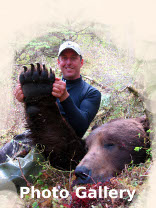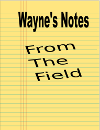Guns and Gear
Rifle Recommendations for Brown bear
I hold to the "use enought gun" school of though regarding Brown bear rifles. I prefer hunting companions to shoot a weapon in the .338 Win Mag to .375 H&H range when bear is likely to be on the agenda. I personnally have a great deal of respect for the amazing toughness that the big bears can display.
My goal is to get as close as is reasonably possible to the intended target and "blow the stuffings" out of it with one well-placed shot. Bears are constantly moving, and often times the shooting angles are changing drastically at the last moment. It is for this reason that I feel a large caliber, heavy bullet that will break big bones and penetrate 48" or more of bear is desirable. The .338 to .416 calibers are the right tools to use under most bear-hunting situations- providing enough "snort" to take a bear at ranges out to 200 yards at most angles.
Shot placement of course is always a critical factor in making a clean kill, and any hunter entering the field needs to be familiar with his weapon, and confident in his shooting ability with it. This requires practice! Anyone headed afield with the intention of harvesting North America's largest dangerous game animal should be comfortable shooting from a number of positions, including the off-hand. Rifles should be equipped with low to medium power scopes; I recommend nothing larger than 2.5 x 8. Scopes also need to carried fixed on the lowest power setting while in the field to be able to find the target quickly during an unexpected close encounter- it can always be turned up should the situation call for higher magnification.
Bullets need to be a good, controlled expansion projectile- we are blessed in that there is a really good variety of premium bullets available these days. The major ammunition makers are now turning out premium cartridges that formerly were only available by handloading. I have experienced good results from North Fork, Nosler Partition, Barnes X, Swift A-Frame, Hawk, and Trophy Bonded bullets on big brown bears.
I have a lot of hunters ask about the use of .300 magnums; in my opinion they are inadequate for the larger bears- and I want to be prepared to to take the best bear possible! Some of this is based on the fact that a great deal of my bear hunting experience has taken place in terrain that has lots of thick cover. That means there is generally not room for a confident following shot, should it be necessary. Recovering a wounded bear in the alder jungle is an experience that few hunters wish to repeat. I have yet to meet the bear hunter that felt "over armed" when faced with the task of tracking a questionably hit bear in dense cover.
Alaskan hunting conditions almost always means "wet". It is advisable to have your rifle in a good synthetic or composite stock; Alaskan field conditions are plain tough on wood even in the best circumstances. Modern sporting firearm makers have generally developed all-weather versions of their hunting rifles to specifically meet this requirement.
My own personal weapons of choice are my .375 H&H ( pre'64 mod 70 win, in a Rimrock stock, 1.5x5 Leupold) as my go-to rifle; for my fall rifle on coastal bears my .416 Rem ( pre'64 mod 70 win Wiseman custom, 1.5x6 Zeiss). I also have an H tropical Ruger No. 1 in .416 Rem. scoped with a 1.75 x 6 Leupold that I use when I am hunting alone. For "loaner" rifles, I have Ruger M77
hawkeyes in .338 win mag, with 2.5x8 Leupold optics.
Download our PDF's gear lists :


